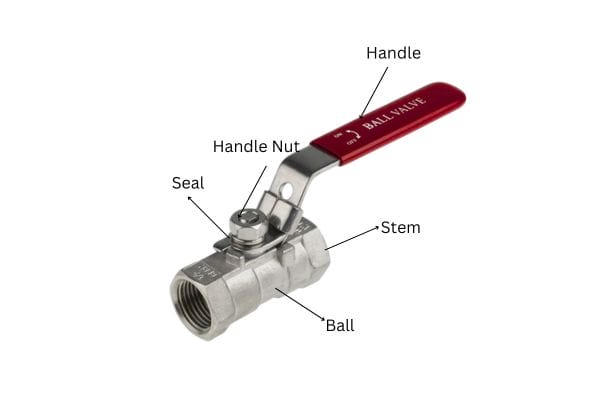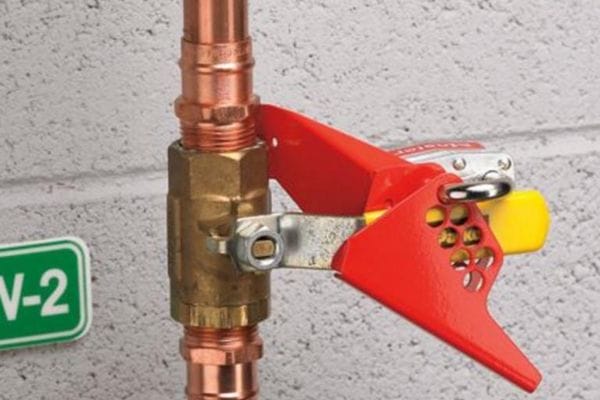Ball valves operate with a simple yet effective mechanism. A spherical ball with a hollow center rotates within the valve body. When the hole aligns with the pipeline, the valve is in the open position, allowing free flow. A 90-degree turn of the handle shifts the ball, closing the flow path. Here’s what you need to know.
Understanding Ball Valve Basics
Anatomy of a Ball Valve: Key Components Explained
A ball valve consists of several critical components that work together to control fluid flow. The most notable parts include:
- Valve Body: This outer casing encases all other components and ensures durability under pressure.
- Ball: A spherical disc with a hole (or bore) through the center. The ball is the central component responsible for flow control.
- Handle: Connected to the stem, this external part allows users to manually rotate the ball.
- Stem: The rod connects the handle to the ball, enabling rotational motion.
- Seats and Seals: These ensure a tight fit between the ball and the valve body, preventing leaks when the valve is closed.
Each component plays a specific role, and together they create a robust mechanism capable of managing high-pressure systems with precision and reliability.
The Role of the Ball in Controlling Flow
The ball within the valve serves as the key element for flow control. When the hole in the ball aligns with the pipeline, it creates a clear path for liquids or gases to pass through. This is known as the open position. Conversely, when the ball is rotated 90 degrees, the solid portion of the ball blocks the flow, putting the valve in the closed position.
This design ensures minimal flow resistance when open and a complete seal when closed, making ball valves efficient for applications where tight shut-off and quick operation are crucial.

Ball Valve Orientation: Parallel vs. Perpendicular Positions
The position of the valve handle is a quick and reliable indicator of whether the valve is open or closed:
- Parallel to the Pipeline: When the handle is aligned parallel to the pipeline, the valve is in the open position. The ball’s hole is perfectly aligned with the flow direction, allowing uninterrupted movement of fluid or gas.
- Perpendicular to the Pipeline: When the handle is perpendicular to the pipeline, the valve is closed. The solid part of the ball blocks the flow, stopping any movement.
How to Identify the Open Position
Ball Valve Handle Position: The First Visual Clue
The position of the handle is the most straightforward way to determine whether a ball valve is open or closed. Manufacturers design ball valves so that the handle alignment corresponds directly to the valve’s position:
- Open Position: The handle is parallel to the pipeline, indicating that the ball’s internal hole is aligned with the flow path. This allows fluid or gas to pass through freely.
- Closed Position: The handle is perpendicular to the pipeline, meaning the solid portion of the ball is blocking the flow entirely.
This visual cue makes it quick and easy for operators to identify the valve’s status without dismantling any components. However, for older or heavily used valves, handle misalignment might occur, requiring additional verification methods.
When Handle Position Isn’t a Reliable Indicator
While a 90-degree handle turn is standard in most two-way ball valves, not all ball valves operate this way. Certain types—especially three-way or multi-port valves—require more complex rotation and cannot always be judged by handle alignment alone.
Multi-Port Ball Valves: T-Port and L-Port
Three-way ball valves, such as T-type and L-type designs, allow for multiple flow paths and often require 180-degree or even 360-degree rotation to switch between modes. In these cases:
- The handle may appear parallel to the pipeline but still block one or more ports.
- Some configurations may partially restrict flow even when the handle is not perpendicular.
This means visual inspection alone may not reveal the actual internal flow path. Always consult the valve diagram or user manual when operating multi-port valves.
Locking Handles and Position Detents
In industrial environments where operational safety is critical, ball valves may include:
- Locking devices: Prevent accidental opening/closing during maintenance or hazardous operations.
- Position detents: Mechanisms that physically “click” the handle into predefined positions (e.g., open, closed, partially diverted).
- Handle limiters or position plates: Visual guides attached to the valve body that indicate current valve mode.
Ball Valve Flow Direction: Understanding the Path
In many cases, ball valves are equipped with markings or arrows on their bodies to indicate the flow direction. These markings provide further clarity, especially when the valve’s orientation isn’t obvious.
- Bidirectional Valves: These allow flow in both directions, with the open position marked by the handle’s parallel alignment.
- Unidirectional Valves: These valves feature arrows that point in the direction of permitted flow, helping users confirm the open position.
Understanding the flow path is particularly crucial in systems where incorrect positioning could lead to leaks, pressure build-up, or operational inefficiencies.
Why Installation Direction Matters for Ball Valves
In systems using unidirectional ball valves, proper installation is critical to ensuring safe and effective operation. Unlike bidirectional valves, which allow flow in both directions, unidirectional valves are engineered to control flow in a single direction only.
Most unidirectional ball valves feature an arrow or flow direction mark engraved on the valve body. This arrow must point in the same direction as the intended flow of fluid or gas. Installing the valve in reverse can result in several operational failures:
- Seal failure: The valve is designed to create a tight seal only when pressure is applied in the correct direction. Reversing the flow can prevent the ball and seats from sealing properly.
- Backflow risk: Incorrect installation can allow fluid to flow backward through the system, potentially damaging equipment or causing contamination.
- Pressure buildup and relief failure: Many valves are equipped with pressure relief features that only function when pressure is applied correctly. A reversed valve may not relieve overpressure, creating a dangerous situation—especially in high-pressure or high-temperature systems.
Using Status Indicators for Accurate Positioning
Many modern ball valves come with built-in status indicators for additional accuracy. These indicators may include:
- Color-Coded Handles: Handles are sometimes marked with red or green labels to signify open (green) or closed (red) positions.
- Visual Windows: Some valves have small windows that reveal whether the internal ball’s hole is aligned with the flow path.
- Mechanical Position Markers: Raised or engraved markers on the valve body or stem show the current position.
Visual and Physical Indicators
How Handle Alignment Reveals the Open Position
The alignment of the handle is one of the simplest and most reliable ways to determine whether a ball valve is open:
- Parallel Alignment: When the handle is parallel to the pipeline, the valve is open. This means the ball’s internal hole is aligned with the flow, allowing fluid or gas to pass through unimpeded.
- Perpendicular Alignment: When the handle is perpendicular to the pipeline, the valve is closed, and the flow is completely blocked.
This straightforward visual cue is a key feature of ball valves, making them user-friendly and efficient in various settings. However, handle misalignment due to wear or damage may sometimes make this less clear, requiring additional checks.
Arrows, Labels, and Markings: What to Look For
Many ball valves feature additional visual aids that help confirm their position:
- Directional Arrows: Some valves have arrows engraved or painted on the body, indicating the flow direction. These arrows make it easier to verify the open or closed state even if the handle position is unclear.
- Open/Close Labels: Labels marked “OPEN” or “CLOSE” on the handle or valve body provide clear, unambiguous guidance.
- Engraved or Raised Markings: Permanent markers on the valve surface are especially helpful in industrial environments where visual clarity is critical.
By paying attention to these markings, operators can double-check the valve’s position quickly and accurately, even in challenging lighting or environmental conditions.
Checking Valve Alignment with the Pipeline
Another effective method for confirming the open position is to visually align the valve handle with the pipeline. This is especially useful in larger systems where other indicators may be obscured:
- Direct Alignment: Stand in line with the pipeline and check whether the handle runs in the same direction as the pipe. If it does, the valve is likely open.
- Inspect for Uniformity: In systems with multiple valves, compare the position of other similar valves to identify whether the alignment appears consistent across the system.
Using the handle’s alignment with the pipeline as a visual guide ensures quick and accurate identification, reducing the likelihood of errors during operation.
Confirming Valve Position Through Functional Testing
While visual inspection—such as handle alignment—is often sufficient to determine whether a ball valve is open or closed, certain applications require functional verification to ensure the valve is truly in the desired position. This is especially important when dealing with:
- Lined or ceramic ball valves where internal components are obscured
- Aging or heavily corroded valves that may have internal resistance
- High-stakes systems where even minor flow deviations can lead to safety issues
Functional Testing Methods
Here are commonly used field techniques to confirm valve status:
Blow-Through Test
- How it works: Apply a controlled air or inert gas stream to one end of the pipe.
- Purpose: If air passes freely through the valve, it confirms the valve is in the open position.
- When to use: Ideal for non-hazardous fluid systems, low-pressure pipelines, or during maintenance.
- Caution: Never use this method on pressurized or hazardous systems without proper isolation.
Low-Pressure Leak Test
- How it works: Pressurize the upstream section with a low-pressure fluid (air or water) and check for downstream flow or pressure build-up.
- Purpose: Detects incomplete closure or internal leakage.
- Tools required: Pressure gauge, manometer, leak detection fluid (or soapy water).
- When to use: Recommended after valve installation or reassembly.
Electronic Position Indicators
- How it works: Some modern valves include or support electronic limit switches or proximity sensors that confirm the ball’s position.
- Purpose: Allows for real-time monitoring of valve status via a control panel or SCADA system.
- When to use: Essential for automated, remote, or safety-critical systems (e.g., power plants, chemical refineries).
Common Misconceptions
Debunking Myths About Ball Valve Operation
Ball valves are often seen as simple, foolproof devices, but several misconceptions can lead to mistakes in their operation. Let’s clear up a few common myths:
Myth 1: Ball Valves Only Work in One Flow Direction
Many people believe all ball valves are unidirectional, but most are actually bidirectional. Understanding the specific type of valve in use is key to ensuring proper operation.
Myth 2: Ball Valves Are Always Leakproof
While ball valves are designed for tight shut-off, wear and tear, improper maintenance, or using the wrong materials for the application can cause leaks over time.
Myth 3: The Handle Position Is Always Reliable
Handle alignment is a helpful indicator, but it isn’t foolproof. Damage, misalignment, or wear in the valve’s internal components can cause the handle to indicate the wrong position.
Recognizing these myths can help users avoid costly mistakes and maintain better control over their systems.
Why the Handle Alone May Not Always Tell the Full Story
While the handle is the primary visual indicator of a ball valve’s position, it isn’t always completely reliable. Situations where the handle might mislead include:
- Worn Mechanisms: Over time, the connection between the handle and the stem can loosen, causing the handle to point in the wrong direction.
- Improper Installation: During installation, if the handle is not securely attached or calibrated, it may not accurately reflect the valve’s internal position.
- Internal Blockages: Debris or buildup inside the valve can prevent the ball from fully rotating, even if the handle suggests it has moved to the correct position.
| Valve Type | Handle Movement | Open/Closed Determination | Notes |
| 2-Way | 90° rotation | Handle parallel = Open | Most common type; simple on/off function |
| 3-Way (L-Port) | Multi-position rotation | Requires flow direction marking | Used for switching flow between two paths |
| 3-Way (T-Port) | Three-way switching | Refer to manufacturer documentation | May allow simultaneous or partial flow paths |
| V-Port Control | Variable angle rotation | Non-standard; based on control logic | Used for precise flow regulation and throttling |
Troubleshooting Position Issues
Signs of a Faulty Ball Valve Alignment
Identifying alignment problems early can prevent costly repairs and system inefficiencies. Look out for these signs of faulty ball valve alignment:
- Flow Disruption: Reduced or irregular flow may indicate the valve isn’t fully open or closed.
- Handle Misalignment: If the handle doesn’t align perfectly with the pipeline when open or closed, the internal ball may not be positioned correctly.
- Leaks Around the Valve: Misalignment can cause the valve seats to lose their seal, leading to leaks.
- Excessive Force Required: Difficulty in turning the handle might signal internal wear, debris buildup, or alignment issues.
Recognizing these warning signs helps operators address the problem before it escalates into a system failure.

When the Handle Is Stuck or Misaligned
A stuck or misaligned handle is a common issue, often caused by the following factors:
- Corrosion: Over time, exposure to moisture or chemicals can corrode the stem or ball, making the handle difficult to turn.
- Debris Build-Up: Dirt or particles trapped inside the valve can prevent smooth rotation, causing the handle to jam.
- Wear and Tear: Repeated use may loosen the connection between the handle and stem, resulting in a misaligned handle.
How to Fix It
- Apply Lubrication: Use valve-specific lubricant to ease movement and protect against future corrosion.
- Inspect and Clean: Disassemble the valve (if safe to do so) and remove debris or buildup.
- Check for Damage: Replace damaged components, such as the stem or handle, to restore proper functionality.
Recognizing Valve Position in Challenging Environments
In industrial and field operations, ball valves are often exposed to extreme or specialized conditions where traditional visual indicators—such as handle orientation or color coding—can become unreliable. In these situations, special consideration must be given to how valve status is confirmed.
Corrosive Environments
In environments such as chemical plants, marine platforms, or wastewater systems, corrosion can deteriorate:
- Labels and tags (making OPEN/CLOSED markings unreadable)
- Handle materials (leading to bending, breaking, or seizure)
- Body coatings (reducing visibility of flow direction arrows)
Suggested solutions:
- Use engraved or embossed markings instead of painted labels
- Select corrosion-resistant materials such as stainless steel, PVC, or PTFE-lined valves
- Apply UV-stable or chemical-resistant tags
High-Temperature Applications
In steam systems, thermal oil loops, or metal-processing lines, heat can:
- Cause thermal expansion that misaligns handles
- Warp visual indicators or limiters
- Make manual operation unsafe without protective gear
Suggested solutions:
- Use heat-rated position indicators or remote actuator feedback
- Ensure handle extensions or gearboxes are used to prevent burns
- Implement thermal insulation covers with access slots for indicator viewing
Common Installation Errors That Affect Positioning
Incorrect installation can lead to long-term issues with ball valve operation and positioning. Here are frequent mistakes to avoid:
- Overtightening Connections: Excessive force during installation can distort the valve body, misaligning the internal ball and affecting handle operation.
- Improper Alignment During Mounting: If the valve isn’t aligned properly with the pipeline, the handle may not accurately indicate the open or closed position.
- Using the Wrong Valve Type: Installing a unidirectional valve in a system requiring bidirectional flow can lead to positioning and operational errors.
Preventative Measures
- Follow Manufacturer Guidelines: Always refer to the valve’s installation manual to ensure proper alignment and torque levels.
- Test Before Finalizing Installation: After mounting, cycle the valve through its positions to confirm smooth and accurate operation.
- Match the Valve to the Application: Choose a valve type that suits the system’s flow requirements and environmental conditions.
Maintenance Tips for Ball Valves
Routine Checks to Ensure Smooth Operation
Regular maintenance is key to keeping ball valves in top condition and extending their lifespan. Include these checks in your routine:
- Inspect the Handle Alignment: Ensure the handle operates smoothly and aligns correctly with the pipeline in open and closed positions.
- Check for Leaks: Examine the valve body and connections for any signs of fluid or gas leakage, which could indicate worn seals.
- Test the Valve Movement: Rotate the handle through its full range to ensure it operates without excessive force or obstruction.
- Monitor System Pressure: Ensure the valve is handling system pressure as designed, avoiding stress that can lead to failure.
These simple checks can prevent small issues from becoming major problems, ensuring uninterrupted operation.
Cleaning and Lubricating the Valve for Longevity
Proper cleaning and lubrication are essential to prevent wear and tear. Follow these steps for optimal care:
- Disassemble Safely: Shut off the system and relieve pressure before disassembling the valve for cleaning.
- Remove Debris: Clean the internal ball, seats, and seals using a soft cloth or non-abrasive brush to remove dirt, scale, or buildup.
- Apply Lubricant: Use a high-quality, valve-safe lubricant on moving parts, such as the stem and ball, to reduce friction and ensure smooth operation.
- Reassemble and Test: Carefully reassemble the valve, ensuring all parts are properly aligned. Test the valve to confirm it functions as expected.
Routine cleaning and lubrication not only enhance performance but also help identify potential issues early.
Preventing Corrosion and Wear in the Ball Valve
Corrosion and wear can significantly impact a ball valve’s performance and lifespan, especially in challenging environments. Here’s how to prevent them:
- Choose the Right Material: Use valves made of corrosion-resistant materials, such as stainless steel or brass, for systems handling harsh chemicals or moisture.
- Apply Protective Coatings: Coat external valve components with anti-corrosion paint or treatment to shield them from environmental factors.
- Minimize Chemical Exposure: If possible, reduce exposure to aggressive chemicals or ensure the valve’s material is compatible with the system’s media.
- Operate Within Design Limits: Avoid exceeding the valve’s pressure, temperature, or flow capacity to reduce mechanical stress and wear.
Conclusion
To ensure reliable operation, conduct routine inspections to detect alignment issues or leaks, clean and lubricate components regularly to prevent debris buildup and corrosion, and follow manufacturer guidelines during installation to avoid errors. By combining these practices with proper maintenance, you can ensure that ball valves remain efficient, dependable, and easy to manage for any application.
FAQ
What is the easiest way to identify a ball valve’s open position?
The easiest way is to check the handle alignment. If the handle is parallel to the pipeline, the valve is open.
Can a ball valve handle be misaligned?
Yes, over time, wear, corrosion, or improper installation can cause the handle to misalign, making additional checks necessary.
What markings indicate a ball valve’s open position?
Markings like arrows, “OPEN” labels, or color-coded indicators on the valve body or handle can show the open position.
How often should ball valves be inspected?
Routine inspections should be conducted at least annually or more frequently in systems with heavy usage or harsh environments.
What materials are best for corrosion-resistant ball valves?
Stainless steel and brass are excellent choices for corrosion resistance in ball valves.
How can I prevent a ball valve from leaking?
Ensure proper installation, perform regular maintenance, clean the valve, and replace worn seals or components when necessary.






